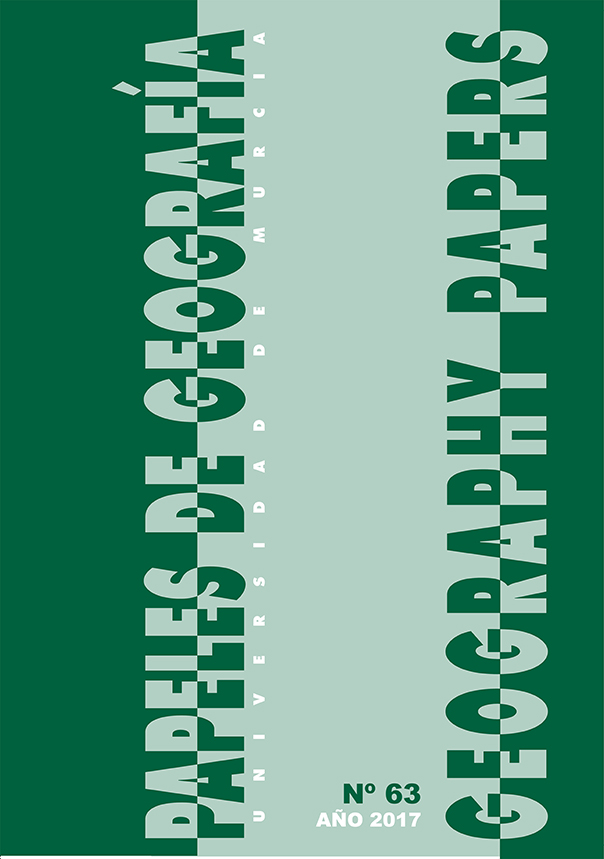Multivariate versus traditional methodology for identification and classification of landscape
Abstract
of this study was to validate an identification of landscape types through a multivariate classification method (TWINSPAN) on the province of Huelva (Andalusia, Spain) by its comparison with a classification developed using non-statistical methods. To this aim, the identification of landscapes types of the Landscape Atlas of Spain was chosen. The comparative analysis shows an optimal degree of similarity between them. This implies the validity of multivariate method, which has also advantages over conventional methods, although probably the excellence is better achieved through a combination of both of them.Downloads
-
Abstract383
-
PDF (Español (España))503
-
PDF503
References
ALCÁNTARA, J. A., & MUÑOZ, J. M. (2015). Estudios geográficos. “Landscape classification of Huelva (Spain): An objective method of identification and characterization”, vol. 76, nº. 279, p. 447-471.
BLANKSON, E. J., & GREEN, B. H. (1991). Landscape and Urban planning. “Use of landscape classification as an essential prerequisite to landscape evaluation”, vol. 21, nº 3, p. 149-162.
BUNCE, R. G. H., BARR, C. J., & WHITTAKER, H. A. (1981). Annual report of the institute of terrestrial ecology. “An integrated system of land classification”, vol. 1980, 28-33.
BUNCE, R. G. H., & HEAL, O. W. (1984). Planning and Ecology. “Landscape evaluation and the impact of changing Land-Use on the rural environment. The problem and an approach”. En ROBERTS, RD & ROBERTS, TM. (Ed). Chapman & Hall. Londres & Nueva York.
BUNCE, R. G. H., CLARIDGE, C. J., BARR, C. J., & BALDWIN, M. B. (1986). Land and its Uses—actual and potential. “An ecological classification of land-its application to planning in the Highland Region, Scotland”. Springer. US, pp. 407-426.
BUNCE, R. G. H., BARR, C. J., CLARKE, R. T., HOWARD, D. C., & LANE, A. M. J. (1996). Journal of biogeography. “ITE Merlewood land classification of Great Britain”, vol. 23, nº 5, p. 625-634.
BUNCE, R. G. H., CAREY, P. D., ELENA-ROSSELLO, R., ORR, J., WATKINS, J., & FULLER, R. (2002). Journal of environmental management. “A comparison of different biogeographical classifications of Europe, Great Britain and Spain”, vol. 65, nº 2, p. 121-134.
CHERRILL, A. (1994). Journal of Rural Studies. “A comparison of three landscape classifications and investigation of the potential for using remotely sensed land cover data for landscape classification”, vol. 10, nº 3, p. 275-289.
CHUMAN, T., & ROMPORTL, D. (2010). Landscape and Urban Planning. “Multivariate classification analysis of cultural landscapes: An example from the Czech Republic”, vol. 98, nº 3, p. 200-209.
CLARIDGE, C. J. (1989). Rural Information for Forward Planning. “The approach adopted by Highland Regional Council", p. 21-28.
COUNTRYSIDE COMMISSION. (1987). CCD. “Landscape assessment: a Countryside Commission approach”, p. 18.
ENGLISH NATURE (1993). Strategy for the 1990s: Natural Areas. English Nature. Peterborough.
FORMAN, R. T. T., & GODRON, M. (1986). Landscape Ecology. John Wiley& Sons. New York, 619 pp.
FOODY, G. M. (2002). Remote sensing of environment. “Status of land cover classification accuracy assessment”, vol. 80, nº 1, p. 185-201.
HABERMAN, S. J. (1978). Analysis of Quantitative Data. Volume 1 Introductory Topics.
HAGEN-ZANKER, A. (2006). Journal of Geographical Systems. “Map comparison methods that simultaneously address overlap and structure”, vol. 8, nº 2, p. 165-185.
HAINES-YOUNG, R.H. (1992): Landscape ecology in Britain, Proceedings of the first international associations of landscape ecology-UK meeting. “Landscape ecology and the countryside information system”. En Haines-Young, R. (Ed.). University of Nottingham. Nottingham.
KENT, M. & COKER, M. (1992): Vegetation Description and Analysis. A Practical Approach. CRC Press, Inc., Corporate Blvd. Florida.
LEGENDRE, P., & LEGENDRE, L. (1998). Numerical Ecology, Volume 24, (Developments in Environmental Modelling).
MOREIRA, J. M. (2003): Geografía de Andalucía. “El relieve y las costas andaluzas I. Las grandes unidades del relieve andaluz”. En López Ontiveros, A. (Coord.). Ariel Geografía. Barcelona.
MOSS, D. (1985). Applied Geography. “An initial classification of 10-km squares in Great Britain from a land characteristic data bank”, vol. 5, nº 2, p. 131-150.
PITA LÓPEZ, M. F. (2003): Geografía de Andalucía. “El clima de Andalucía”. En López Ontiveros, A. (Coord.). Ariel Geografía. Barcelona.
SANZ HERRÁIZ, C., MATA OLMO, R., GÓMEZ MENDOZA, J., ALLENDE ÁLVAREZ, F., LÓPEZ ESTÉBANEZ, N., MOLINA HOLGADO, P. AND GALIANA MARTÍN, M. (2003). Atlas de los Paisajes de España. Centro de Publicaciones. Secretaria General Técnica. Ministerio de Medio Ambiente. Madrid.
The manuscripts published in Papeles de Geografía are subject to the following terms and conditions:
1. The publishing house of the University of Murcia (Servicio de Publicaciones de la Universidad de Murcia) keeps the copyright of the published manuscripts favouring and allowing the use and distribution of such works under the licence in 2 below.
© Servicio de Publicaciones, Universidad de Murcia, 2011
2. Manuscripts are published electronically under an Attribution Non-Commercial No Derivatives 3.0 Unported Creative Commons Licence Spain (Legal text). Readers are free to copy, use, share and redistribute the material in any medium or format as long as (i) appropriate credit is given to authors and original source (journal, publishing house and URL); (ii) the material is not used for commercial purposes and (iii) this licence and restrictions are stated.
3. Self-archive. Authors are allowed and encouraged to distribute pre-print versions (prior to evaluation) and/or post-print versions (after evaluation and accepted for publication) of their manuscripts. This favours the dissemination and early distribution of scientific knowledge and citing.





